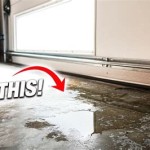Gel Stain for Garage Doors: Enhancing Aesthetics and Protection
Garage doors, often a prominent feature of a home's facade, play a significant role in curb appeal. Over time, factors such as weather exposure and general wear and tear can diminish their aesthetic appeal. While painting is a common solution, gel stain offers an alternative that can enhance the beauty of wood or simulate the look of wood on other materials, while also providing a layer of protection. This article provides a comprehensive overview of using gel stain on garage doors, covering its benefits, preparation processes, application techniques, and maintenance considerations.
Understanding Gel Stain
Gel stain differs significantly from traditional wood stains. It is characterized by its thick, gel-like consistency, which makes it particularly well-suited for vertical surfaces like garage doors. Unlike liquid stains that can run or drip easily, gel stain adheres well, providing a more uniform and controllable application. This consistency derives from the inclusion of thickening agents, such as gelled oils or resins. These components contribute to the stain's ability to coat surfaces evenly and resist penetration into porous materials, resulting in a richer, more consistent color.
The composition of gel stain typically includes pigments, binders, and solvents. Pigments provide the desired color, while binders hold the pigments in suspension and adhere them to the surface. Solvents control the viscosity and drying time of the stain. The specific types and ratios of these components vary across different brands and formulas, affecting the stain's performance and durability. Some gel stains are designed for interior use, while others are formulated for exterior applications, incorporating UV absorbers and weather-resistant resins to protect against sun damage and moisture. It’s critical to select a gel stain specifically labeled for exterior use when staining a garage door.
Gel stain’s versatility extends to its ability to adhere to a wide range of surfaces. While primarily used on wood, it can also be applied to fiberglass, metal, and even painted surfaces, making it a viable option for garage doors constructed from various materials. This adaptability allows homeowners to achieve a wood-like appearance on non-wood garage doors, enhancing their aesthetic appeal without the expense or maintenance associated with real wood.
Preparation is Key: Ensuring Optimal Adhesion and Finish
Proper preparation is crucial for achieving a professional-looking and long-lasting finish with gel stain. The steps involved depend on the material of the garage door and its existing condition. Thorough cleaning is always the first step. Remove any dirt, grease, mildew, or loose paint using a mild detergent solution and a stiff brush or sponge. Rinse thoroughly with clean water and allow the door to dry completely. This stage is critical because any contaminants left on the surface can interfere with the stain's adhesion and result in an uneven or blotchy finish.
For wood garage doors, sanding is often necessary to create a smooth and receptive surface. Start with a coarser grit sandpaper (80-120 grit) to remove any existing finish or imperfections, and then move to a finer grit (220 grit) to smooth the surface. Sanding opens the wood pores, allowing the gel stain to penetrate and adhere effectively. After sanding, remove all sanding dust with a tack cloth or a vacuum cleaner with a brush attachment. Failing to remove the dust will result in a gritty texture in the final finish.
Fiberglass and metal garage doors require different preparation techniques. For fiberglass, lightly scuff the surface with fine-grit sandpaper to create a mechanical bond for the gel stain. For metal, use a degreaser to remove any oils or residues. Applying a primer specifically designed for the material is highly recommended. A primer provides a uniform base for the gel stain to adhere to, ensuring better coverage and durability. Choose a primer compatible with both the garage door material and the gel stain you intend to use.
Masking off areas that should not be stained, such as windows, hardware, and trim, is another essential preparation step. Use painter's tape to create clean, crisp lines and prevent the stain from accidentally getting on unwanted surfaces. Applying a thin, even layer of petroleum jelly to hardware can also protect it from stain. Remember to remove the tape shortly after applying the stain while it is still wet to prevent peeling or chipping of the finish.
Application Techniques for Gel Stain on Garage Doors
The application of gel stain requires careful attention to detail to achieve the desired results. Use a high-quality brush, foam brush, or lint-free cloth to apply the gel stain. The choice of applicator depends on the desired effect and the texture of the garage door. Brushes are generally preferred for detailed work and creating a wood-grain effect, while foam brushes are suitable for smooth, even coverage. Lint-free cloths are excellent for wiping away excess stain and achieving a more subtle, translucent finish.
Apply the gel stain in thin, even coats, working in the direction of the grain for wood garage doors. Avoid applying too much stain at once, as this can lead to drips and runs. For fiberglass and metal doors, apply the stain in a consistent pattern to mimic the look of wood grain. Work in small sections at a time to maintain control and ensure uniform coverage. Overlapping strokes can create darker areas, so focus on even distribution.
After applying the stain, allow it to sit for the recommended time specified by the manufacturer. This dwell time allows the stain to penetrate the surface and achieve the desired color intensity. The dwell time varies depending on the product and the desired effect. For a deeper, richer color, allow the stain to sit for a longer period. For a lighter, more subtle color, wipe off the excess stain sooner. Use a clean, lint-free cloth to wipe away any excess stain, following the direction of the grain. This step is crucial for creating a smooth, uniform finish and preventing the stain from becoming sticky or tacky.
Multiple coats of gel stain may be necessary to achieve the desired color depth and coverage. Allow each coat to dry completely before applying the next. Lightly sand the surface with fine-grit sandpaper between coats to create a smooth, receptive surface for the next layer of stain. Remove all sanding dust before applying the next coat. This process helps to build up the color gradually and create a more durable finish.
Once the final coat of gel stain has dried completely, apply a clear coat of exterior-grade polyurethane or varnish to protect the finish from the elements. The clear coat provides a durable, weather-resistant barrier that protects the stain from fading, chipping, and scratching. Choose a clear coat with UV absorbers to prevent sun damage. Apply the clear coat in thin, even coats, following the manufacturer's instructions. Allow each coat to dry completely before applying the next. Multiple coats of clear coat may be necessary to achieve the desired level of protection.
Maintenance and Longevity of Gel-Stained Garage Doors
Proper maintenance is essential for preserving the appearance and extending the lifespan of a gel-stained garage door. Regular cleaning is the first line of defense against dirt, grime, and mildew. Wash the door periodically with a mild detergent solution and a soft brush or sponge. Rinse thoroughly with clean water and allow it to dry completely. Avoid using harsh chemicals or abrasive cleaners, as these can damage the stain and clear coat.
Inspect the garage door regularly for any signs of wear and tear, such as scratches, chips, or fading. Address any issues promptly to prevent further damage. Small scratches and chips can be touched up with a matching gel stain. Clean the affected area thoroughly before applying the stain. Apply the stain sparingly with a fine-tipped brush or cotton swab. Allow the stain to dry completely before applying a clear coat touch-up. For larger areas of damage, it may be necessary to re-stain the entire section of the door.
Reapplication of the clear coat may be necessary every few years to maintain its protective properties. The frequency of reapplication depends on the climate and the level of exposure to the elements. Areas with high levels of sun exposure or frequent rainfall may require more frequent reapplication. Before reapplying the clear coat, clean the garage door thoroughly and lightly sand the surface to create a receptive surface for the new coat. Apply the clear coat in thin, even coats, following the manufacturer's instructions.
Protecting the garage door from direct sunlight can also help to extend the life of the gel stain. Planting trees or shrubs to provide shade can reduce the garage door's exposure to UV radiation. Applying a UV-resistant sealant can also help to protect the stain from fading. Regularly lubricating the garage door hardware can also help to prevent damage and extend the life of the door. By following these maintenance tips, homeowners can enjoy the beauty and durability of their gel-stained garage doors for years to come.

Gel Stain Garage Door Refinish Crochet It Creations

Staining Your Metal Garage Door Anderson Doors

How To Gel Stain Garage Doors Longbourn Farm

How To Gel Stain Garage Doors Longbourn Farm

How To Gel Stain Garage Doors Longbourn Farm

Another Garage Door Update With Minwax Gel Stain

Gel Stain Garage Door Life S Dirty Clean Easy

Faux Wood Garage Door Tutorial Fake How To Gel Stain A

Create A Faux Wood Garage Door With Gel Stain Crazy Life Littles

How To Gel Stain Garage Doors Longbourn Farm








